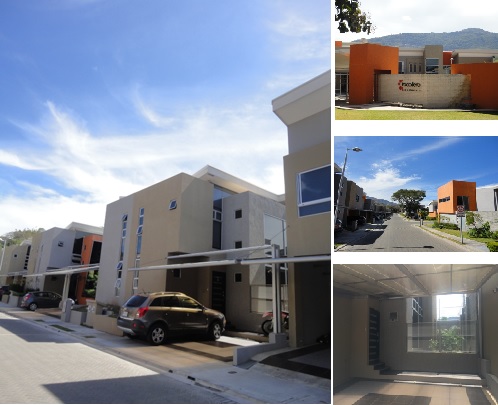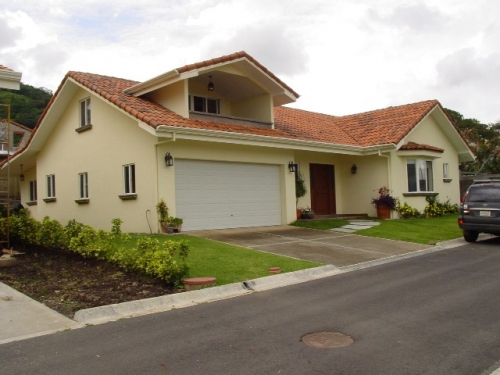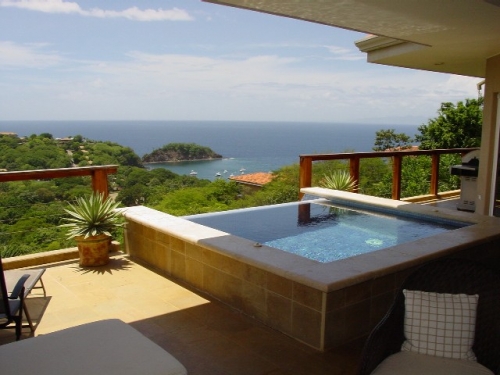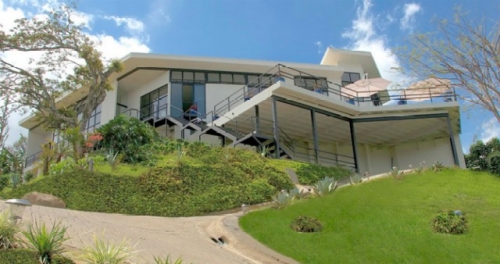Costa Rica Guide
Costa Rica Real Estate
List your property today!
Inclusion of real estate listings at Costa Rica Guide is
absolutely free of charge.
Featured Properties
Costa Rica Guide - Costa Rica Real Estate
On the Edge in Costa Rica
He wanted more than butterfly farms. He got it.
By Linton Weeks, Staff Writer
The Washington Post
October 24, 2004
As our rental car skittered down an extremely steep stone-and-gravel road near the Turrialba Volcano, I silently wondered if we were going to get out of Costa Rica alive.
We did.
It took us hours to descend just a few miles into the valley of the lost city of Guayabo. The whole time I was thinking: Surely we can find a safer way to get out of here.
We did.
Costa Rica can be hard. And it can be easy. It can be perturbing and paradisiacal. It can be restrictive: No nudity on the beach. And it can be permissive: Prostitution is legal. The country has a split personality and the ironies make the "rich coast" even richer.
If you know of Costa Rica only for its ecotourist traps, volcano tours, butterfly farms and zip lines through the rain forest canopy, you don't know the half of it. Not the half that we discovered, anyway.
Here are four discoveries.
Puerto Viejo de Limon
My wife, Jan, my 15-year-old son, Holt, and I landed in San Jose. We were meeting old friends -- Billy and Jacqueline, also visiting Costa Rica -- on the Caribbean side of the country, which is about the size of West Virginia. So we made straight for Puerto Viejo, a beachy village about 120 miles southeast of the capital. The thoroughfare to that part of Costa Rica was long, slow, tortuous, hauntingly beautiful and both uncrowded and crowded at the same time.
It's a double-edged country, remember.
At various times we shared the road -- the road -- with casual strollers, horseback riders, bicyclists, children sitting cross-legged and potholes the size of hot tubs. The drive took more than five hours.
We were going to the seashore during Holy Week, a popular time for Costa Ricans, but as fortune would have it, we still found inexpensive and rustically elegant lodging at La Costa de Papito.
Just south of Puerto Viejo, the hotel is a landscaped compound of 10 bungalows and a reception area, with a few old board games, a lending library, a bamboo bar, a pool table and honor coolers full of soda, juices and Costa Rican beer.
We were ushered to Los Delfinos, a lovely little cabin with a tile floor, three beds, a couple of windows and, mercifully, a ceiling fan. The dark-wood walls didn't quite reach all the way up to the ceiling, but strategically placed screening let in Caribbean breezes and kept out jungle critters.
There was an outpost feeling to Puerto Viejo, the air full of exotic aromas and taboo possibilities. The seaside town moves to its own rhythm, far from the rest of the world. People are friendly. Though we didn't run into many Americans, there was a Stateside slant to the place. Some merchants take dollars as well as colones. That's fortunate, because there are no ATMs in Puerto Viejo -- yet. Rumor has it that a bank will soon open here.
For now, townsfolk direct you to an industrious, dark-haired man who has a little hole-in-the-wall currency exchange spot at the front desk of Los Almendros apartments near the police station.
There are no drugstores either. Or supermarkets as we know them. If you want Q-Tips, for instance, you have to ask around to find the man who sells them. He runs a small shop near the bakery. You can also buy some Costa Rican bug spray there. But no corkscrews or machetes. For those you have to search out the beach store down the dirt road. Every small errand becomes an adventure.
A sign hanging in front of the Lotus Restaurant advertised a bookstore called David's Library. The "bookstore" was a loft above the restaurant that was obviously somebody's room. The bed was unmade. There was a guitar propped against a wall and old pipes lay crossways in an ashtray. There were a few shelves of used books for sale, most in English, but others in Spanish, Dutch, German and French.
Downstairs, we ordered lunch. Jan and I feasted on a cooling meal of shrimp salad with bananas, mayonnaise and papaya. Holt had red snapper in a sweet and sour sauce with rice. The cafe also featured the requisite broken-down bicycle, man in a hammock and dog.
Though there was little to do in Puerto Viejo besides walk among the vending booths that sold anklets and earrings, and dine, we ventured in nearly every night. Like the country, it seemed both safe and edgy. Double-edgy.
Deserted Beaches
Just a short walk across the road from our bungalow was a beautiful, uncrowded beach. Most days, the only interlopers besides our family were some talented surfers. The sand was hard and packed, the waves soft and rolling.
We found several deserted beaches between Puerto Viejo and the town at the end of the road, Manzanillo. On one we spoke with Rex, an architect from St. Louis. "Welcome to Paradise," he said.
Billy, Jacqueline and their tween daughter, Laura, were staying in a treehouse a few hundred yards from Playa Cocles, a postcard-perfect cove with a scimitar-shaped beach. Every evening a three-toed sloth climbed a tree just outside one of their windows and hung upside down all night. There were reports of other exotic creatures, such as white-faced monkeys and constrictors as big around as two-liter soda bottles, in their yard -- which a local gardener manicured with a machete.
In Costa Rica, there seem to be two national pastimes: repairing vehicles (bicycles, motorcycles, cars, trucks, buses, etc.) and battling the jungle. Old-timers still ride horses and carry machetes. The new generation pedal bikes and wield gas-powered weed whackers.
We were told that the best snorkeling in the area is at Punta Uva. On one of the days we hung out at the beach, we put our towels down in the sand. Nearby, an enterprising woman grabbed several long pieces of driftwood and, in the Costa Rican manner, constructed an out-of-the-sun lean-to . . . for her three dogs.
And now a word about dogs: Puerto Viejo is lousy with them. They wander in and out of cafes. They stroll down the middle of the road, unmoved by the long line of creeping cars behind them. A couple of dogs usually found us each early morning enjoying breakfast -- spicy eggs, granola, fresh fruit and smooth Costa Rican coffee -- on our porch or in the reception area. Like the pups, Holt especially liked lounging on the breezy porch. We would often discover him splayed out in the hammock, eating a banana or reading a book.
We rented horses from a no-frills stable not far from our bungalow. Our rock-steady guide, Melby, led us along the road, which we shared with cars and children and potholes, to a wooded path. Once through the trees, we arrived at a gorgeous beach, with crashing surf and a volcanic outcropping in the distance. My horse, Palomo, was a wise old steed, too smart to chase after the younger horses and riders in our group who galloped down the beach like outlaws. Holt's horse was so brash he sank in quicksand to his chest and Holt had to hop off.
Not exactly an expert equestrian, I knew Palomo and I were in trouble when a trio of large dogs rushed our posse. The dogs barked and snarled and nipped at the heels of the horses. The otherwise slow-pokey Palomo suddenly burst into warp speed. I jammed my feet into the stirrups and my right cinch broke. My saddle began to slide. I was falling off a runaway horse. I called to Billy, who is half-deaf, and to Melby, who spoke no English. They both smiled at my speed and gave me a supportive thumbs up.
God bless Palomo. That old horse seemed to know exactly what was happening, and as soon as we outran those damnable dogs, he slowed down and stopped. I dismounted to explain my predicament to our guide. As I began, I saw out of the corner of my eye a large woman in a small bikini running up the beach waving my stirrup in the air. Behind her, the three snarling dogs.
This time Melby took Palomo's reins and held the horse calmly while thanking the woman, taking the stirrup and tying the leather strap so that we could ride back to the stable without incident.
We did.
Path to Punta Mona
Ecotourists are migrating to Costa Rica in massive numbers. According to the Washington-based Center on Ecotourism and Sustainable Development, more than 1.1 million tourists are visiting Costa Rica every year. The center points out that the tourist industry is scrambling to provide hotels and restaurants and enough sexy attractions to appeal to the thundering herd. And it raises the critical question: How should Costa Rica "take advantage of demand for protected habitat to build healthy tourism industries . . . while still maintaining the integrity of the resources tourists want to visit?"
Nearly everywhere we turned, we saw ads for newly built rain forest excursions, some offering vast platforms connected by swinging bridges or slides, others using long slides or aerial trams. We decided to see the viney sights on our own.
On a Friday morning we followed Billy and Jacqueline in our car to Manzanillo, beyond which there is just jungle for miles. And then Panama.
We parked in sand near the beach behind Restaurant Maxi, a beachside Afro-Caribbean eatery and bar. And we started walking. We waded across a rivulet that led into the sea and we picked up an ancient coastal path. The sand became dirt; the dirt, mud. As we hiked deeper and deeper into the jungle, we passed through stands of gargantuan trees and ferns the size of Humvees. Overhead, we began to hear strange sounds, like long, low grunting sounds. "There are the howler monkeys," Jacqueline said. "We will see them."
We walked for another couple of hours. We spotted exotic birds, including a long, red macaw, several scarlet-red tree frogs (said to be poisonous) and spiders the size of my hand. We did not see the monkeys.
When the going got steeper, we used roots as footholds and grapevines as tow ropes. We came upon a clearing that turned out to be a small banana finca in the middle of nowhere. The owners must travel by horse because there were no discernible roads to be found.
Eventually the path got too muddy to continue. We were just shy of Punta Mona, a little fishing village named for the howler monkeys we had heard but not seen.
Jacqueline found a side path. As we made our way toward a beach, she pointed into the trees and there were a dozen or more howler monkeys, silent now and watchful. They moved like shadows in the trees.
Lost City of Guayabo
On our last day in Costa Rica, we drove back toward San Jose, but before reaching the capital city, we took a detour into the central region to visit the lost city of Guayabo.
Finding the lost city was not easy.
Several people told us the way to go and we found signs pointing us from the town of Turrialba to Guayabo National Monument. The descent to the archaeological site was death-defying. We inched our way down a gravelly one-lane road. That's when I wondered if we were going to survive.
We were slowed even more when the car of Costa Ricans in front of us stopped and everyone except the driver poured out to walk the last couple of miles to the site.
Guayabo is a 50-acre park. Only a small percentage has been excavated. Historians believe that the city was inhabited by 10,000 or so people from 1000 B.C. until A.D. 1502. No one is sure why the inhabitants left. The abandoned city was reclaimed by the jungle and lost to the known world for several hundred years.
A little over a century ago, Guayabo was rediscovered, between two rivers and in the shadow of Turrialba Volcano. An ancient stone road runs through the site. The bases of various structures, such as a temple and a market, have been preserved. Archaeologists also found a complex aqueduct system.
When we finally eased our car into the welcome center's parking area, there were a handful of tourists and a few guides waiting to show people around the monument. Fortunately we were paired with Edgardo Soto, a gentle-souled student at the nearby University of Costa Rica.
As he walked us through the reconstruction, he said, "I always talk about the structures, but that is not what I like the most."
He said there seems to be in Guayabo a "door to a spiritual world." He spoke of the religious vibes. And as his soft voice searched for the right words in English, the site had the feel of holiness, and there was in the constant breezes a sense of otherworldliness. A pair of brilliantly bright toucans zipped from one tree to another. Gorgeous butterflies flitted about.
Soto explained that Guayabo may have been a cultural bridge between the Aztecs of Mexico and the Incas of Peru. More than 60 petroglyphs have been found so far at Guayabo, most taken to a museum in San Jose. Soto showed us a couple that remain, one depicting water and another of a man's face.
Little is really known about Guayabo, he said.
And in many ways, it is still a lost city.
I felt like that about the whole country. There is much that is known about Costa Rica; there is a lot that is not.
We weren't sure, for instance, how to get the hell out of Guayabo.
We told Soto about our crazy drive in. He smiled and said there was a smoother road out. He pointed in the opposite direction from the way we entered. He said to follow the little byway for a mile or so until we came to a paved highway, then turn right. That would take us back to Turrialba.
We did.
Our return was easier. But not much quicker. Traveling through a high-mountain town, we ran into a fantastic religious parade with people in costumes and children dancing about.
It was a serendipitous moment. One of many in Costa Rica. It was a wonder-filled celebration we hadn't planned on. Appropriately enough, we discovered that the village was called Paradise.
Linton Weeks last wrote for Travel about the rocking side of Nashville.
Details: Costa Rica
GETTING THERE: We flew American Airlines from Dulles to New York to San Jose, and returned via Miami. United flies nonstop from Dulles for about $413 round trip; connecting service on such carriers as Delta and American starts at around $380 round trip.
GETTING AROUND: A rental car is essential to cruising around Costa Rica. Buses, we were told, are often over-packed and unpredictable. Most major companies rent cars in San Jose. We rented through Payless; the weekly base rate for our intermediate four-door was $180.
WHEN TO GO: Dry (high) season runs late December to mid-April. For pleasant weather that's neither too wet nor too dry, go between April and May, or mid-October to mid-December. Throughout the year, temperatures average about 89 degrees on the coast and 62 degrees inland.
WHERE TO STAY: We holed up in a lovely cabin at La Costa de Papito (outside Puerto Viejo near Playa Cocles, 011-506-750-0080, greencoast.com/papito.htm). Advertised as "bungalows on the Caribbean for the noble savage," the no-frills resort is not for the luxury-minded. Proprietor Eddie Ryan, however, has combined beauty and basics to create a pleasant haven. Rates run from $31 to $56, depending on season and bungalow size.
The less adventuresome might like Villas del Caribe, (506-233-2200, www.villasdelcaribe.com), which is also south of Puerto Viejo. It has seaside rooms, a breezy cafe and a ping-pong table near the front desk. Double-occupancy rooms, with breakfast included, cost $105 or less, depending on the season.
WHERE TO EAT: There is good food everywhere, and it's pretty cheap. One night we waited forever for our dinner at Selvin's, south of Puerto Viejo.The wait was well worth the while. We enjoyed fish and lobster and, for dessert, small chocolate rolls with bits of ginger that we bought from a jar at the register. Entrees were about $10 apiece.
Another night we drove to the south end of the coastal road, to the town of Manzanillo. The electricity was out, as it often is. But Restaurant Maxi was prepared. Folks dined by candlelight. As we headed for our table, the electricity returned and there was a cheer. Our Caribbean chicken, red snapper and lobster were exquisite. Entrees were about $10.
SNORKELING: The best mask-and-fin action in the area was at Punta Uva, among the coral reefs. To get there, go south from Puerto Viejo past La Costa da Papito, cross three bridges and take the second left. On one day the water was murky from recent -- and frequent -- rains; another day it was choppy. But the beach is lovely and a few pretty fish swam by.
INFORMATION: Costa Rica Tourism and Travel Bureau, 800-343-6332, www.visitcostarica.com.
© 2004 The Washington Post Company
Note: The above information is not to be used for any other purpose other than private study, research, criticism or review. Thank you.






